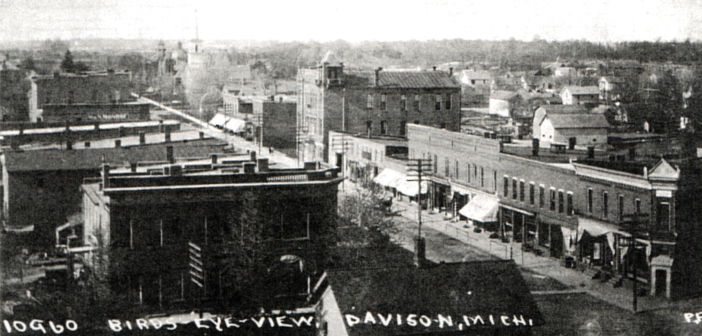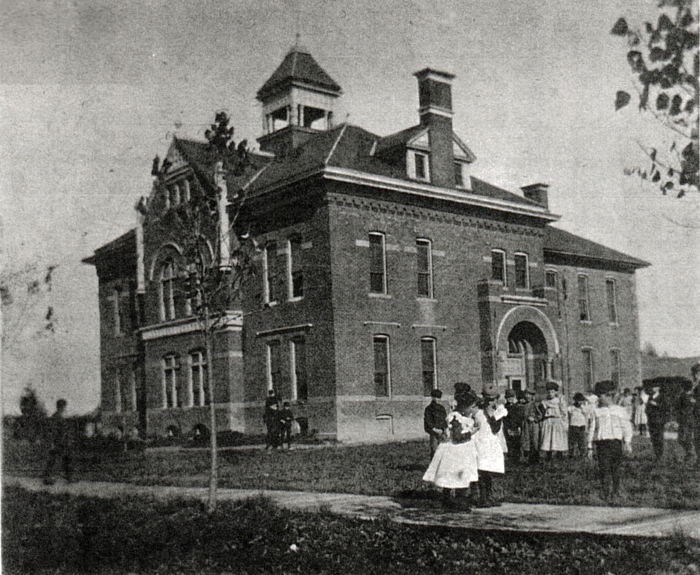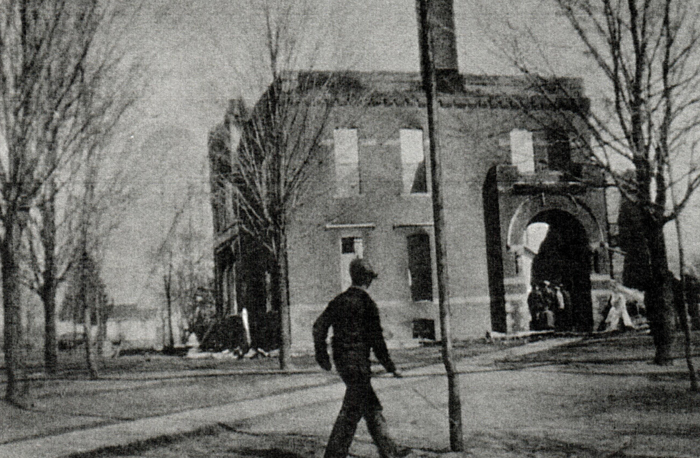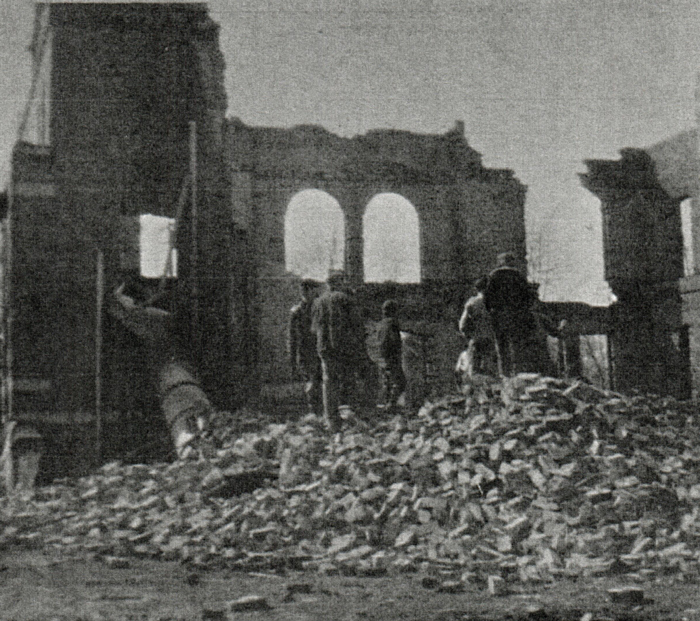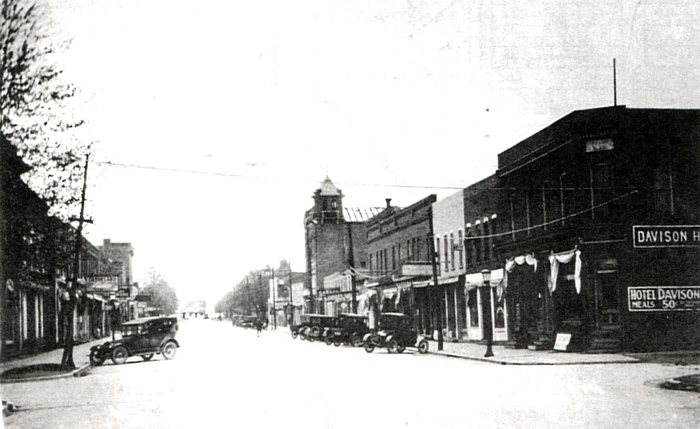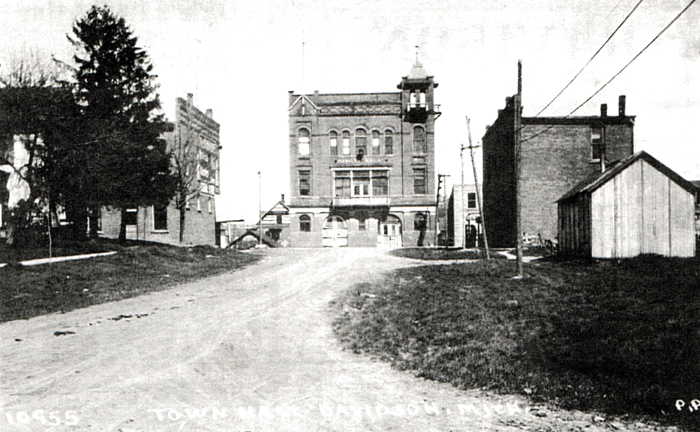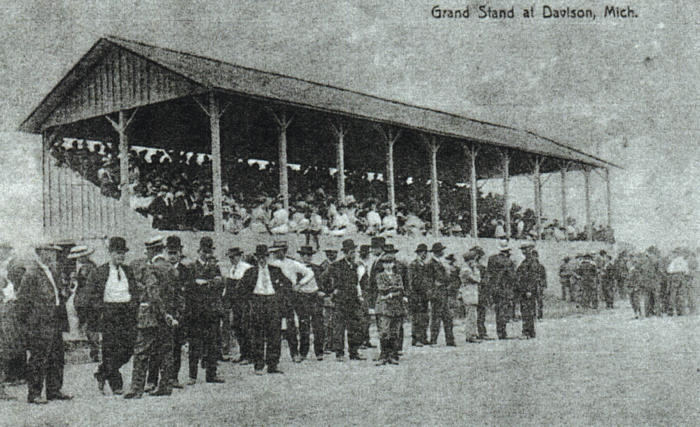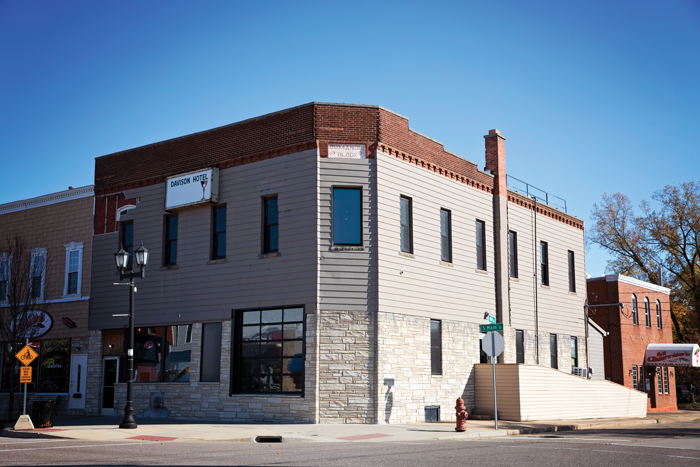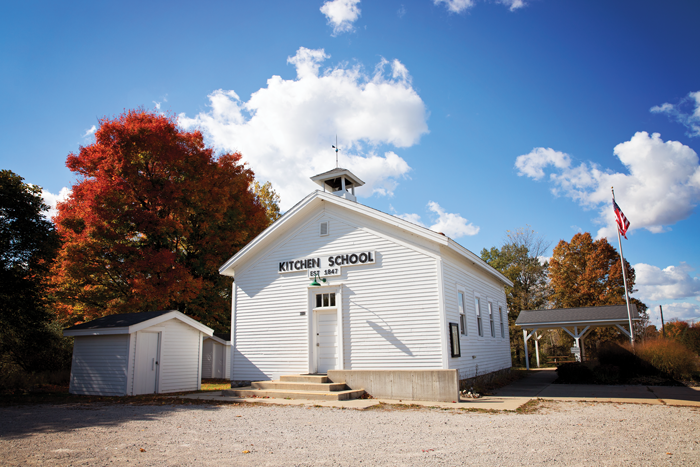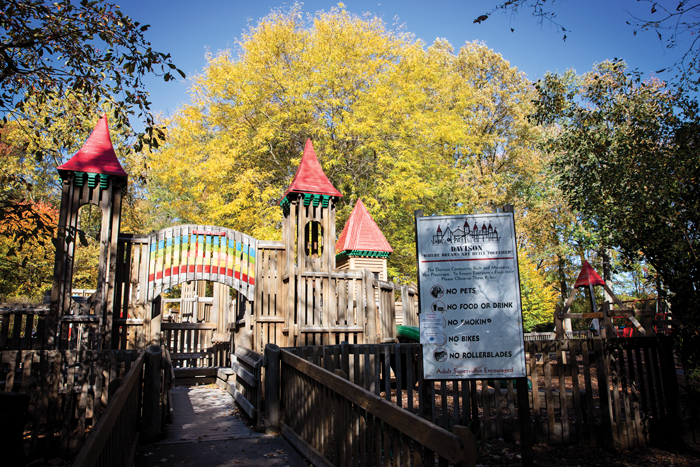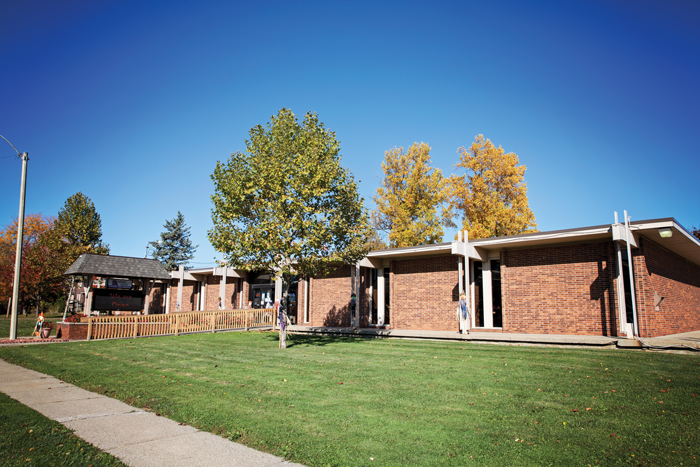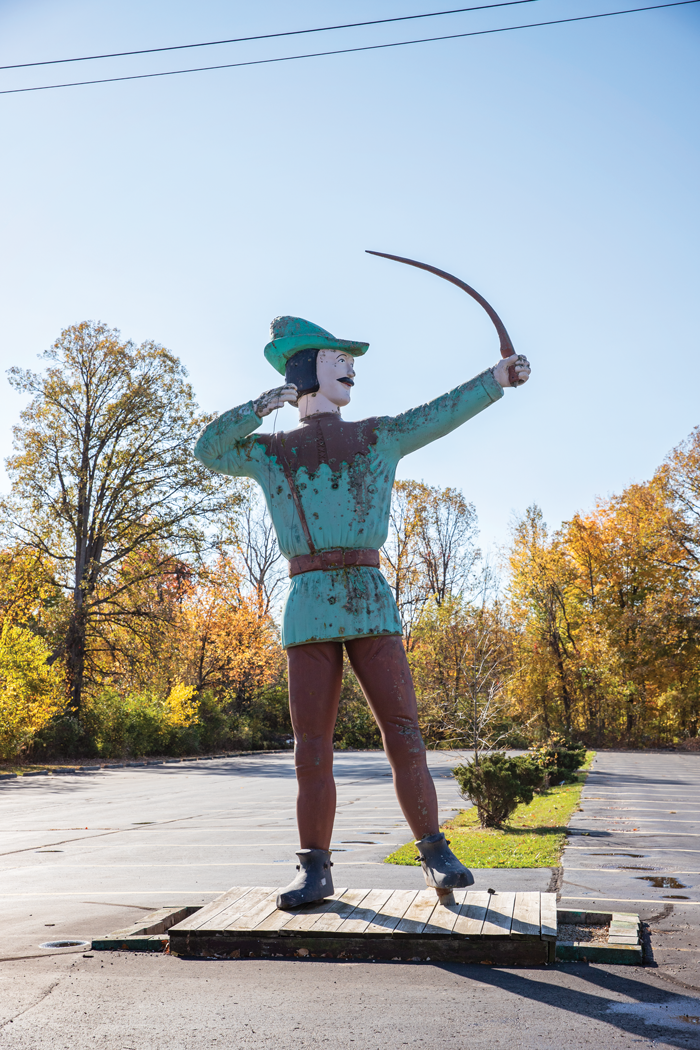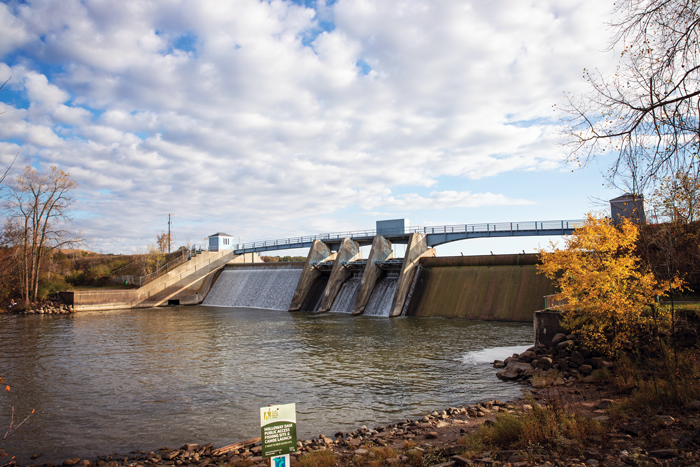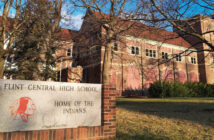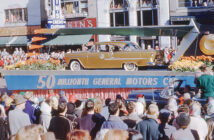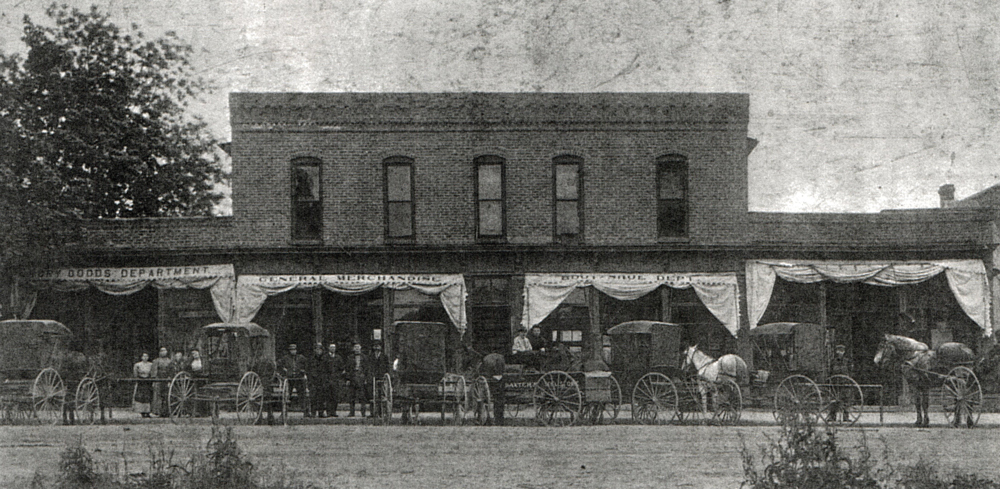
Davison and Richfield Townships Settled: 1836
Orsimus Cooley, the famous guide and pathfinder, was busy escorting a duo of travelers through the wilds of Richfield Township to a gathering in Genesee. As they traversed the woods, Cooley thought he heard the sound of a large, foraging animal. Being near a known deer run, Cooley separated from his charges and brought his rifle to bear hoping to kill the animal for a later meal. Slowly, he made his way through a dense thicket and reaching the other side was shocked to find a bear waiting no more than 30 yards out. Being one he recognized as a troublemaker, he leveled his weapon and fired. The bear jumped once and fell. Cooley quickly reloaded and was lucky that he did, because another bear quickly entered the clearing. He again fired, dropping the second bear. After one more reload, Cooley exited the thicket at the same time a third beast came into view. One more shot was fired and one more bear was dead. The travelers, being called by the gunfire, drew up behind Cooley. Three bears with three shots! They were flabbergasted. The Genesee County pioneers were certainly a cut above.
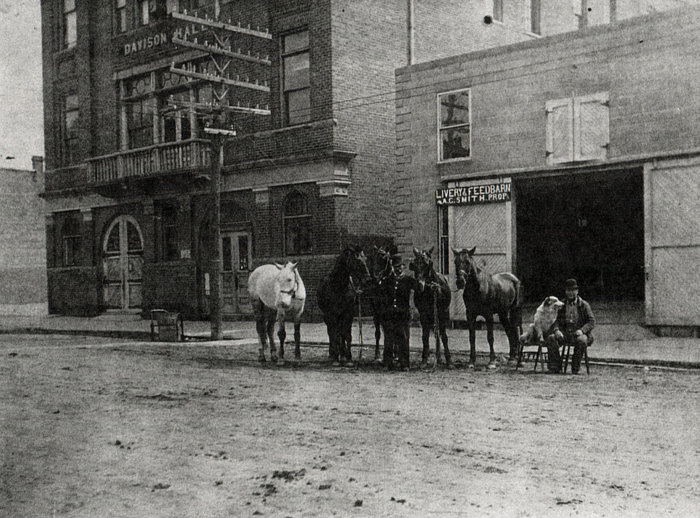 The Early Pioneers
The Early Pioneers
In fledgling Genesee County, the mid-1830s was a busy time. Travelers were arriving from all directions and staking claim to any free land they found. As houses were built and fields sowed, commerce, education and society grew. Genesee County as we know it today was shaped by the hard work and determination of these early enterprising men and women.
In 1836, one such man, Andrew Seelye, fought his way north from Waterford to become the first settler in the land that would someday become Davison Township. He constructed the area’s first house and farm. In 1838, his family finished the township’s first framed building but, alas, Seelye died before its completion. Soon thereafter, Christopher Miller arrived and built the first framed house. The first school was started in a vacant shanty on his property, taught by Miss Sabrina Barnes.
In 1837, pioneer Ira Potter set off from the mill in Genesee with the goal of creating a road to land he purchased in Davison on the shores of the now-named Potter Lake. Over a period of three days, he and a few associates carved out a road and built a small log cabin on his property. In 1838, the Potter family took up their new residence. A year later, Ira died at age 47. The first boy born in the Township was his grandson, Ira, in 1840. Joining the Potter family in the year 1838 were the Henry, Sheldon, Conger and Cartwright families. The same year that Potter was building his road, Norman Davison and Asa Farrar built the first highway through the township. Davison lived in the northern part of present-day Atlas Township and was a delegate at the framing of the state constitution. The current township was named after him and his family, but the township would have never come to be if not for the work of another.
 Goodenough Townsend arrived in 1836 and quickly got to work. At the time, the township’s south half was a part of Atlas and the north a part of Richfield. Townsend and other residents petitioned the state legislature for creation of a new township to be named Middlebury. The legislature granted the request but was vexed when they realized that Middlebury Township already existed; an alternate name needed to be found and agreed upon. During the ensuing argy-bargy, the name of a prominent citizen was bandied and the legislature eventually chose to honor the name of the Davison family in Atlas Township. At the first township meeting in 1840, Townsend was named supervisor, a role he would fill on and off through the rest of his days. In 1843, Townsend was instrumental in the annexation of Richfield and Davison townships from Lapeer County to Genesee.
Goodenough Townsend arrived in 1836 and quickly got to work. At the time, the township’s south half was a part of Atlas and the north a part of Richfield. Townsend and other residents petitioned the state legislature for creation of a new township to be named Middlebury. The legislature granted the request but was vexed when they realized that Middlebury Township already existed; an alternate name needed to be found and agreed upon. During the ensuing argy-bargy, the name of a prominent citizen was bandied and the legislature eventually chose to honor the name of the Davison family in Atlas Township. At the first township meeting in 1840, Townsend was named supervisor, a role he would fill on and off through the rest of his days. In 1843, Townsend was instrumental in the annexation of Richfield and Davison townships from Lapeer County to Genesee.
In 1852, Seth Wicker took up residence and opened the first hotel on the present corner of M-15 and Lapeer Rd. His was a prominent stop on the Flint-to-Lapeer stage line and the area surrounding his hotel came to be known among travelers as Wicker’s Corners. A general store and post office were located there. A year later, Pine Grove Cemetery was laid out, one of the county’s earliest. The majority of township pioneers are interred therein, including the Seelye and Townsend families. In 1847, the Kitchen School was built on Seelye land and today stands as a historical building. (The building underwent renovations in 1940.)
When the railroad came to the area in 1871, commerce and population grew. A small village grew up in and around Davison Station as it came to be called, with Misters Dunn & Darling establishing the first sawmill in its boundary. With the mill came the town’s first doctor, D. W. L. Hanson, first merchant, Damon Stewart, and E. W. Rising, the first tavern keeper. The next year, a cheese factory was started by I. W. Potter and Sanford McTaggart that led to great success until a competitor, the Atlas and Davison Union Cheese-Making Company, was founded in 1876. The first high school was erected in 1886 on the corner of Main and Flint streets to accommodate all of the new area youth.
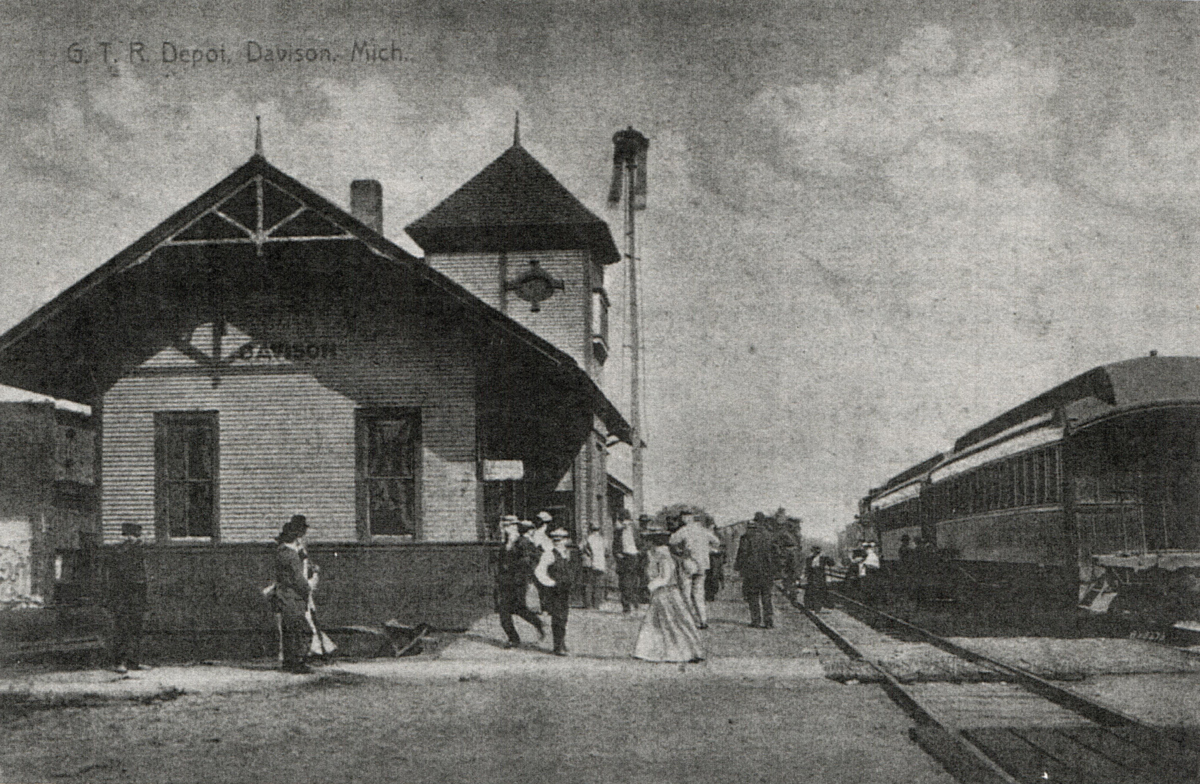
After Davison was officially incorporated as a village in 1889, the famed Davison Hotel was opened in 1892 on the land of Seth Wicker. It was the first location with central heating. A year later, the Ladies Library was opened in the village proper, which outgrew multiple locations until the present building was built in 1968.
As the Seelye family arrived in Davison Township, Rial Irish was busy forging a road north. Accompanied by his brother, wife and three small children, Mr. Irish cleared a 20-mile path to the forested land in Richfield Township that he would call home. After his passage, the road was used by many a pioneer to travel to the lands in the northern end of the county and it came to be called the “Irish Road.” He was the first to sow wheat in the area and a year later, built the township’s first sawmill. Irish would not stay for long, as more lucrative lands were made available to the north and he left in 1839, selling his mill to David Belden. The early settlers joining Irish included James Seymour, William Draper, Hiram Dodge (Dodge Rd.), Asa Davis (a preacher of some renown) and Thomas Clark who planted the first apple trees in the township. (Davis first met Clark in Detroit where he offered to find him adequate land for the sum of $7. Clark accepted and was convinced to move his family north to Genesee.)
The year 1837 brought Orsimus Cooley, a man of the wilds and pathfinder of some esteem, and William Teachout (Teachout Rd.) who erected the area’s first framed barn. The town’s first recorded death was Sarah Clark, who succumbed to tuberculosis. William Draper and E. B. Witherbee from Pontiac worked hard to improve Irish Rd. to the point where it became one of the county’s finest thoroughfares. Next, they dammed the Flint River and built one of the best sawmills in town. It was toward the end of 1837 when Richfield Township was so established by the state legislature. The first post office was located in the house of Phineas Tucker in the small community of Richfield Center (located at M-15 and Coldwater Rd.).
The first school was built in 1838 by Phineas and Isaac Tucker and Orsimus Cooley. Lessons were taught by Miss Hannah Tucker and Miss Hart. The township’s first blacksmith was Ambrose Eckler and first physician was Dr. John Deming, who arrived in 1858 and settled in Richfield Center.
 In 1846, another small community – Rogersville – was established by brothers Laban and Alvah Rogers on Mt. Morris Rd. It became a small stop on the railroad in 1872, complete with its own post office. The railroad did not want to invest in a depot in such a small establishment, so the citizens got together and built their own. In 1875, R. D. Rogers built a small hotel while brother, C. W., built and operated a small cheese factory there. In 1857, another small and short-lived community grew when Captain Maxfield built a steam mill and employed a number of men. As the workers moved in and set up small housing around the area, Maxfield built a large tavern to accommodate them. It was always intended to call the village Richfield but instead, it came to be known as Maxfield’s to all those who knew of it.
In 1846, another small community – Rogersville – was established by brothers Laban and Alvah Rogers on Mt. Morris Rd. It became a small stop on the railroad in 1872, complete with its own post office. The railroad did not want to invest in a depot in such a small establishment, so the citizens got together and built their own. In 1875, R. D. Rogers built a small hotel while brother, C. W., built and operated a small cheese factory there. In 1857, another small and short-lived community grew when Captain Maxfield built a steam mill and employed a number of men. As the workers moved in and set up small housing around the area, Maxfield built a large tavern to accommodate them. It was always intended to call the village Richfield but instead, it came to be known as Maxfield’s to all those who knew of it.
In 1871, the area Agricultural Society declared the farm of Simeon R. Billings of Richfield Township the best of Genesee County. Billings was a man of sound mind and organization who was twice elected state representative and senator between terms as township supervisor. The century ended with scandal in the township when it was found that residents George Oliver, Joseph Morford and his wife embezzled funds from the township highway commission (of which Oliver and Morford were members) for personal gain. Each got off easy, receiving no more than a slap on the wrist.
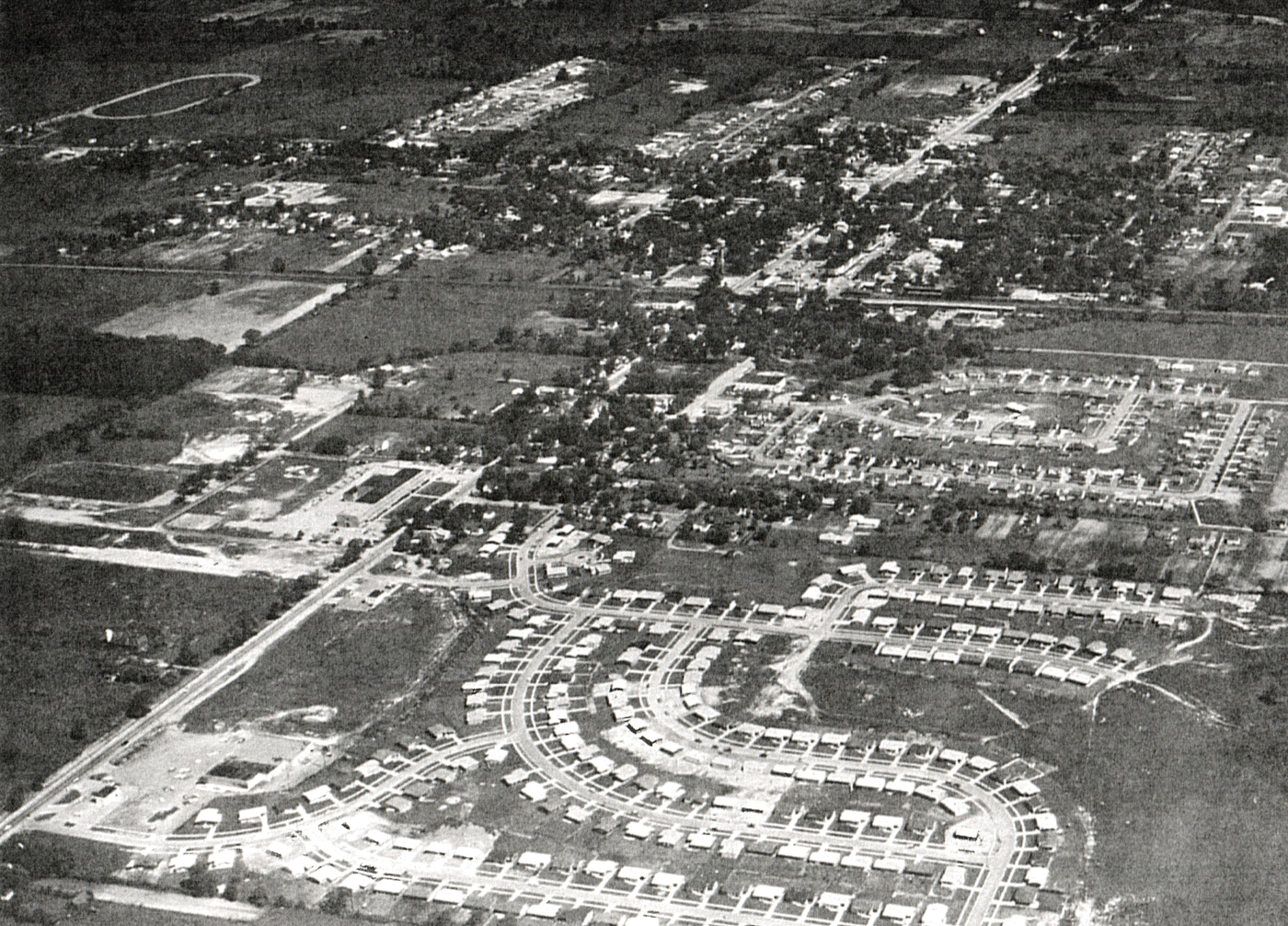
The Contemporary Era
As the century turned, Davison and Richfield Townships began to hit their stride. In 1904, Davison was a sought-after entertainment spot as county fairs took place on the grounds that became the Rosemore Park subdivision. Horse races were held down Main Street until some years later, when fire destroyed the stables. Commerce boomed in town and Davison grew quickly in population and was incorporated as a city in 1938.
In Richfield Township, the focus in the early 1900s was on land, nature and conservation and it became a place for sportsmen and the outdoors; so, it made sense to place the first county park within its confines. In late 1929, the county commissioners saw the need for a county park system and in 1935, land was purchased for the first park that would become Richfield County Park. The Genesee County Road Commission sponsored a Works Progress Administration project to work the land and they quickly began to clear it – building bridges, roads, shelters and tennis courts. The iconic Richfield stone bridge was finished in 1938. The park would continue to grow throughout the years, with fishing access and the now-retired Goldenrod Beach. Other park novelties include a competition-level BMX track, canoe and kayak launch and the Goldenrod Disc Golf Course. Perhaps on their time off, the park workers traveled a mile or so down the road to the Russellville Ballroom to catch a big-time entertainer and dance the night away. The ballroom was one of the county’s most popular spots through the late 30s and early 50s, now demolished. In 1955, the land was altered with the construction of the Holloway Dam. Constructed for fresh water conservation and land augmentation, the dam created the Holloway Reservoir, a favorite summer location for county residents. In the small community known as Richfield Center, a family-owned store opened in 1962 and the Fishing Tackle Grab Bag continues to serve Richfield area sportsmen today. In 1978, the county parks capitalized on the popularity of the reservoir by opening Wolverine Campground and Buttercup Beach.
As the land was changing in Richfield Township, the population was changing in Davison. So much so, that two additional school buildings had to be built in town. By 1930, the school was in session when the building caught fire. Students were all evacuated as the school burned to the ground. When a new building was proposed, many tax-payers fought against it. Only after two elections and a court decision did the plans move forward. The new high school, now Central Elementary, opened in 1931. More schools would be added in the years to follow including Hill Elementary and Thompson Elementary in 1958, Davison Middle School (and Collins Field) in 1962, Siple Elementary in 1964 and Gates Elementary in 1966. In 1972, the current high school was built and Hahn Intermediate school was added in 1998.
In 1961, the Jaycees of Davison needed funds for a project. After much deliberation, they decided to ride the wave of patriotism and sell American flags to merchants. Soon, Old Glory popped up all over town. The Jaycees continued selling flags each year. In 1964, Donald Smith and Donald Parks worked on a small film about the city with a working title of “Davison – City of Flags.” The name floated about town for years until finding its way onto official city stationery in 1969, where it remained. In 1973, signs were erected at city entrance points bearing the motto and in 1975, then-Mayor David Purdie formally adopted the motto and Davison officially became the “City of Flags.”
Davison was again a hotbed of entertainment when businessman Don Sherwood and legendary Flint radio deejay, Peter Cavanaugh, opened Sherwood Forest. Built on a little farm in the township, the venue would host raucous concerts between 1968 and 1974, featuring such bands and musicians as Bob Seger, Ted Nugent, Chuck Berry, MC5, Bo Diddley, Mitch Ryder, Mickey Dolenz, Blue Oyster Cult, REO Speedwagon, Joe Walsh and many, many others. Thousands attended the “Wild Wednesday” shows and weekend events.
In 1962, the Davison Country Club opened and would remain the area’s premier golf experience until Sugarbush Country Club opened in 1995 and Copper Ridge in 2000. The Davison Athletic Club opened in 1978 to become a community focal point. Outdoor recreation was further developed with the additions of the Davison Dog Park (2011), the Black Creek Trail (2013) and Lake Callis (2015). In 2017, the Robert Williams Nature & Historical Learning Center was opened featuring a 100-acre park, township historical museum, event center and classrooms.
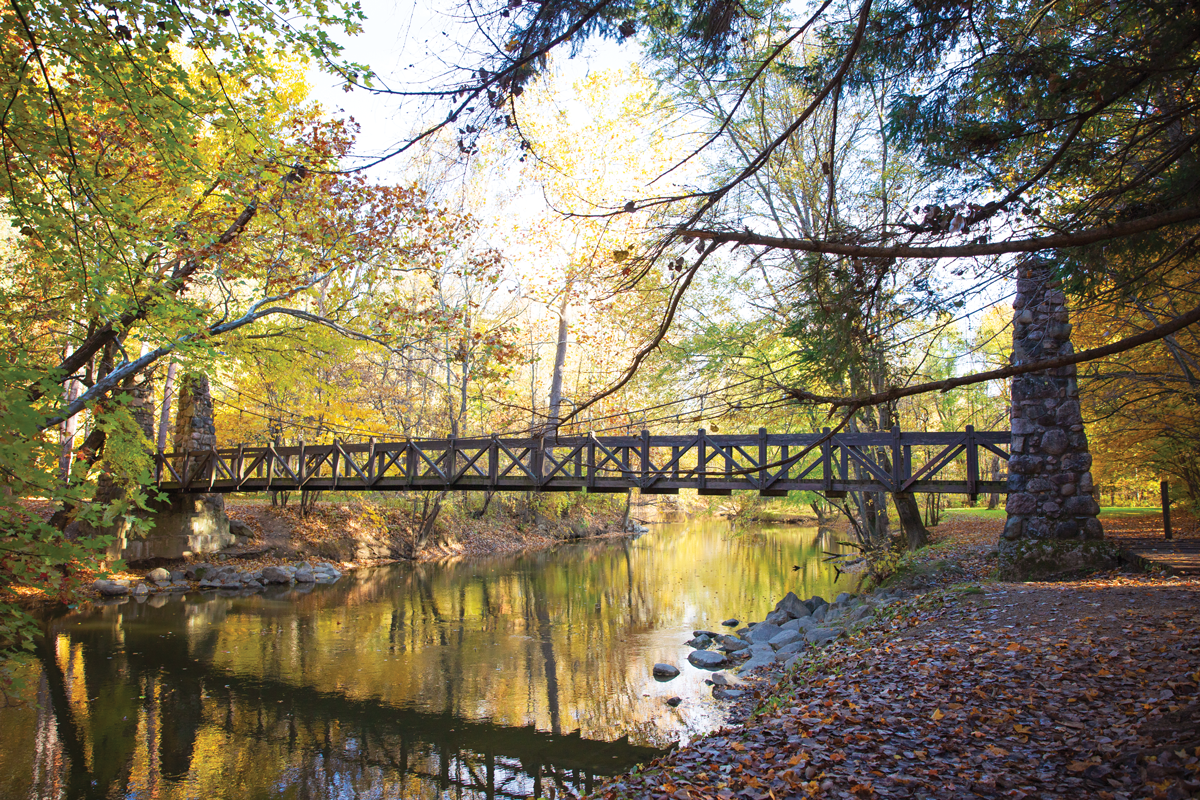
Davison and Richfield Townships are perfect for the sportsman and those who dream of getting back to nature. The forests, trails, lakes and streams offer beauty and adventure to all who visit and its citizens are a perfect example of the rugged fortitude of the county’s early pioneers.
Photos provided by The Davison Historical Society & by Kayce McClure
References
Acosta, R. (2019). Renovations to 125-year-old Davison Hotel. Mlive.com. Retrieved from mlive.com/news/flint/2018/05/renovations_to_125-year-old_da.html
City of Davison. (2020). History of Davison. City of Davison. Retrieved from cityofdavison.org/DocumentCenter/View/33/Davison-History?bidId=
Davison Schools. (2020). Our History. Davisonschools.org. Retrieved from davisonschools.org/Domain/12
Ellis, F. (1879). History of Genesee County Michigan. Everts & Abbott. Philadelphia, PA.
Leonardi, J. (2009). Holloway Reservoir. Michigan Department of Natural Resources. Retrieved from michigan.gov/documents/dnr/2009-60_272568_7.pdf
Wood, E. (1916). History of Genesee County Michigan. Federal Publishing Company. Indianapolis, IN.
Woolcock, J. (2018). Our parks – our gems – are worth celebrating. Eastvillagemagazine.org. Retrieved from eastvillagemagazine.org/2018/07/31/commentary-at-50-year-milestone-our-parks-our-gems-are-worth-celebrating/#:~:text=The%20first%20park%20to%20be,launching%20our%20county%20park%20system.

